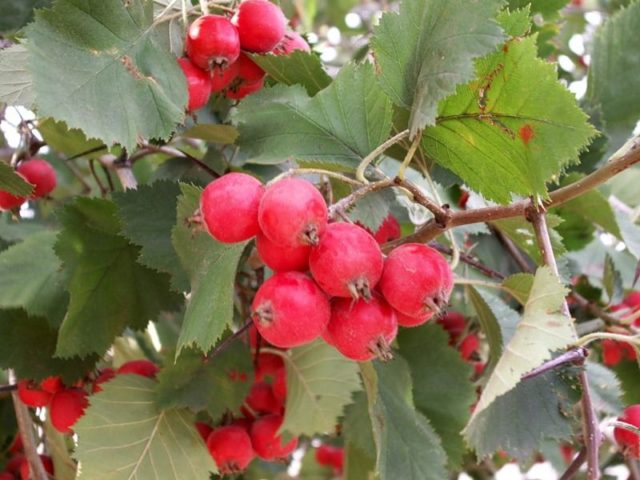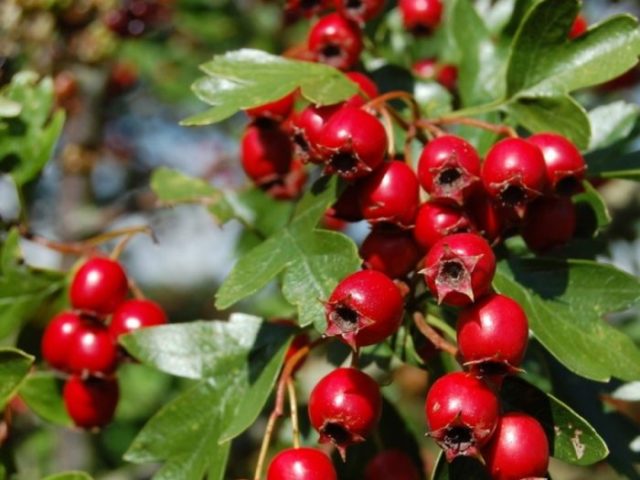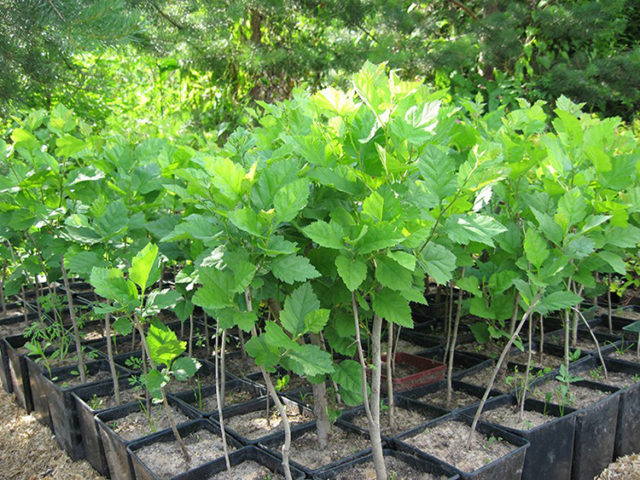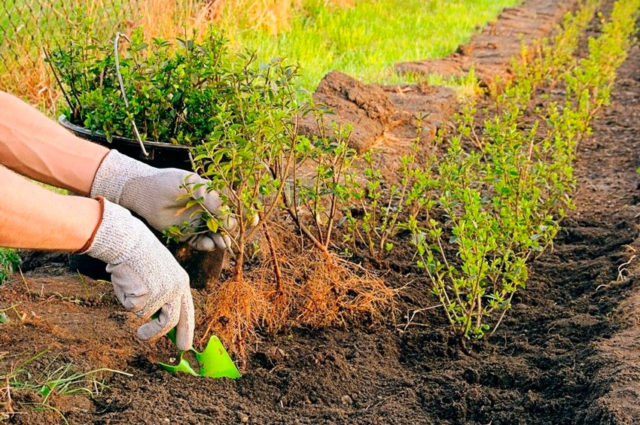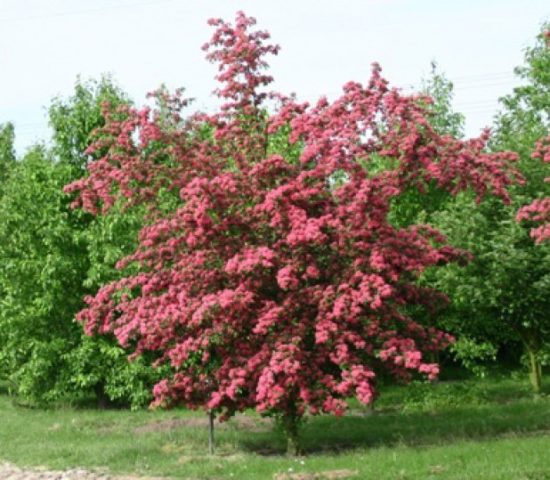Content
Hawthorn softish is a versatile plant that includes aesthetics, functionality, and unpretentiousness. Semi-soft hawthorn is equally good in hedges or as a single flowering ornamental shrub, as a medicine or as a component to create a culinary masterpiece.
Breeding history and distribution area
The soft hawthorn is a typical representative of the flora of North America. The habitat stretches from the northeast of the Atlantic coast to the southwest, including the central states of the United States, to Canada. Grows on forest edges, slopes with moist soil. The plant has been cultivated since 1830. In Russia, the semi-soft hawthorn is widespread; it can be found throughout the European part. Grown in the southern, central, central black earth zone.
Description of softish hawthorn
The hawthorn is semi-soft (soft), presented in the form of a tree, less often a shrub 6-8 m in height. The crown is densely branched, spherical in shape. Young shoots are green, old ones are light gray, with numerous thin slightly curved spines up to 8 cm long.
The foliage is ovoid or oval, with 3 or 4 pairs of lobes. The base is cut, broadly wedge-shaped. The apex is pointed. The leaves are at first strongly lowered, gradually becoming bare, over time, pubescence remains only on the veins. On the edge of the foliage has a jagged edging. In summer, its color is dark green, in autumn it becomes red-brown. Leaves do not fall off for a long time.
Blooms in large inflorescences of 12-15 flowers. The size is 2.5 cm in diameter. Flowers are placed on long peduncles. Inflorescences are tomentose, loose. Sepals are red, 10 stamens. The flowers contain a lot of essential oil, so the pleasant scent is carried over long distances.
The fruits of the semi-soft hawthorn can be seen in the photo. They are pear-shaped, orange-red or crimson-red, up to 2 cm long. The berries are slightly pubescent, with small whitish blotches. The pulp is somewhat dryish, mealy, softish. Ripe fruits have a dessert taste, since they contain up to 15% sugar. Edible.
Species characteristic
The description of semi-soft hawthorn testifies to its decorative properties. From spring to autumn, it pleases with a lush crown, bright, large inflorescences, original fruits, colorful leaves. The tree blooms in May, fruits appear by September. Fruiting occurs at the age of 6 years. Up to 20 kg of berries are harvested from one plant.
Drought resistance and frost resistance
Semi-soft hawthorn (softish) is a winter-hardy tree. It is able to withstand frosts down to - 29 ° С. Adult specimens do not need shelter, and the roots of young plants need protection from freezing.
The tree tolerates the drought period normally. Hawthorn softish - a drought-resistant crop that does not require abundant watering.On the contrary, an excess of moisture will have a detrimental effect on the root system.
Disease and pest resistance
Semi-soft hawthorn is affected by infections that worsen the appearance, and also reduce resistance to negative external factors. The main ailments of semi-soft hawthorn: various spots, rust, powdery mildew, rot.
Pests also have a negative effect on the semi-soft (soft) hawthorn. Dangerous are the kidney mite, worm, false shield, sawfly, weevil, scale insect, apple aphid.
Features of planting and care
For the full development of the softish hawthorn, like other types of shrubs, it requires adherence to the rules of care. In order for the fruits to be soft, large and tasty, a good planting site should be chosen for the plant.
Recommended timing
On garden plots, semi-soft hawthorn is preferably planted in the spring or autumn. Planting in the fall is considered more successful. Before frost, the root system is able to get stronger and adapt to new soil. During the winter, strength is gained for the further vegetation process. The softish hawthorn blooms in May, and the fruiting process begins closer to September. As a rule, a tree planted in the fall already blooms in the spring.
Choosing a suitable site and preparing the soil
In the varietal description of soft hawthorn it is indicated: planting will be most successful if you choose a sunny place for it in the garden. Open, wind-protected areas are ideal for the plant. As for the desired substrate, then the situation is simpler. Hawthorn semi-soft grows well in any, even dense and heavy soil. It is great if the selected area has a rich humus layer.
Before planting, fertilize the soil in advance. To seal the pit, sod land, humus, peat and sand are combined in proportions of 2: 2: 1: 1. In addition, manure and the top of the soil can be added to the planting mixture. Desired soil acidity pH 7.5-8. It should be noted that the softish hawthorn has a highly branched, powerful, long root system. This factor must be taken into account when forming a depression.
What crops can and cannot be planted nearby
With semi-soft hawthorn bushes, it is not recommended to plant fruit trees. They have poor compatibility due to the same diseases. It is believed that softish hawthorn attracts pests that are dangerous to the apple tree. The distance between crops must be at least 300 m.
Landing algorithm
- A 70x70 cm hole is dug in the selected area.
- A drainage layer of broken brick, crushed stone or expanded clay, 15 cm thick, is laid at the bottom of it.
- 30-40 g of lime or 50 g of phosphate rock is also sent to the pit.
- A semi-soft hawthorn seedling is placed in the center of the recess and sprinkled with earth. It is not necessary to deepen the root collar much, it should be 3-5 cm above the ground.
- The earth around the roots is carefully poured and tamped.
- At the end, you need to water the young softish hawthorn with warm water.
- At the end of planting, the near-stem circle is mulched with peat.
You can use a fan-shaped planting method. Several plants are laid in one depression. The result is a beautiful and compact group. If you plan to plant another tree, then the distance between them should be left within 2 m.
Follow-up care
The semi-soft hawthorn variety is undemanding to care for, but this does not mean that it is completely canceled. When growing a shrub, you should devote time to weeding, pruning, feeding.
- Hawthorn soft is not a moisture-loving plant. In cool weather, it will be enough to pour 10 liters of water under the bush. This volume is enough for a month, more often it is not worth moisturizing.Since excess moisture can lead to decay of the roots and the death of the plant itself. On hot days, semi-soft hawthorn should be watered 2-3 times a month.
- For proper development and obtaining a decent harvest of berries, the culture must be nourished. It is recommended to apply fertilizers 2 times per season. First time: in early spring before the beginning of the growing season, using nitrophosphate. The second time - during flowering, use slurry, 8 liters under a tree.
- Every spring, the near-stem circle is dug to a depth of 15-20 cm. Immediately after that, they mulch. Mulch prevents the appearance of weeds, retains moisture in the soil. Use sawdust, hay, straw as mulch. The mulching layer should be no thinner than 10 cm. At the end of the season, the natural material is removed, and the earth under the semi-soft (softish) hawthorn is dug up. Before wintering, lay the mulch layer again to protect the roots from frost.
- In early spring, preventive pruning is carried out, removing dry, diseased, damaged branches. The tree is thinned out, providing air and light access. Branches that grow up are also shortened.
- It is necessary to decide on a permanent place for semi-soft (soft) hawthorn until the age of six. Over time, the root system grows, and transplantation becomes impossible.
Diseases and pests, methods of control and prevention
Semi-soft (soft) hawthorn is affected, as a rule, by fungal diseases. Prevention is spraying with a fungicide. Wood processing takes place at about the same time as garden trees. The pest is dealt with by means of insecticides.
Breeding features
Basically, experienced gardeners use 2 methods of propagation: layering and cuttings. You can get semi-soft (soft) hawthorn by means of seeds, but this process is quite laborious and troublesome.
For grafting, you need samples 10-12 cm long. They are added in early spring or autumn in a greenhouse. And when the cuttings get stronger and start growing, it's time to transplant to a permanent place.
Areas of a plant that have their own root system are suitable as layering. Such a layer must be dug up and separated from the mother rhizome with a sharp knife. After that, plant in a separate pit with a pre-laid drainage.
Application in landscape design
The semi-soft (soft) hawthorn variety has a special decorative effect. The bushes are striking in their beauty from early spring to late autumn. Dense crown, bright flowers immediately attract attention. Most often, this variety is used to make hedges. Growing up, the branches of the tree become an impenetrable fence, not inferior in reliability to brick and metal materials. As you can see in the photo, soft hawthorn can be made in the bonsai style.
Conclusion
Hawthorn softish - a plant that does not need anxious care. Grows well even in unfertilized soils. It is developing rapidly. Hawthorn semi-soft is preferred by connoisseurs of personal space. A hedge of trees will become an impenetrable and impenetrable obstacle due to the long and sharp thorns.
